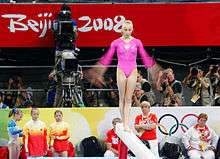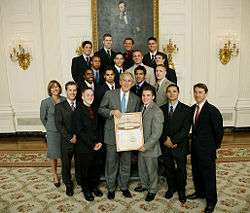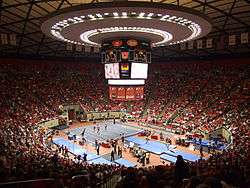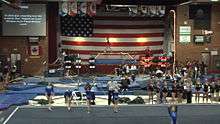Artistic gymnastics in the United States
| Artistic gymnastics in the United States | |
|---|---|
| Governing body | USA Gymnastics |
National competitions | |
International competitions | |
Artistic gymnastics is widely regarded as an underrated and growing sport in the United States, with a smaller, largely female, fan following. In the modern era of women's artistic gymnastics, the United States is regarded as one of the leaders in the sport.
Organization
The over-seeing national governing body for artistic gymnastics, and all gymnastics disciplines, is USA Gymnastics. Since its establishment in 1963, USAG has been responsible for selecting national teams, providing training facilities, encouraging participation and building a strong gymnastics program that involves all types of athletes. USA Gymnastics is a member of the continental Pan American Gymnastics Union, referred to as PAGU[1] and is also part of the international federation, International Federation of Gymnastics.
Elite program
The international elite level is the highest level you can reach in USA Gymnastics for artistic gymnastics, permitting gymnasts to compete in domestic elite competitions, make U.S. national teams and represent the country at World Championships and the Olympic Games.[2] It estimated that a competitive gymnast's chances of making this level are 1-5%.[3] To qualify to elite status, there are various criteria to separate the elite-worthy gymnasts from the elite trialist who may not be ready for elite status at that particular time. As of 2015, first-year elite trialists must score 51.500 (Junior) or 53.000 (Senior) in a 2015 National Elite Qualifier event to gain a berth to international elite status. For returning elite participants, gymnasts must have competed at the previous year's U.S. Nationals. To qualify for the 2015 U.S. Nationals, there are no automatic qualifiers for Juniors and qualification spots are decided from 2014 scores or results from 2015 Classic. For seniors, they receive automatic qualification if they represented the U.S. during the season or at the 2014 Worlds.[4] In the men's program, gymnasts qualify to the Nationals through a National Qualifier event.[5]
USA Gymnastics at the Olympics
The first time the United States Olympic Committee sent U.S. athletes to compete in artistic gymnastics was at the 1904 Olympics, held in St Louis, Missouri. The United States team won every event excluding the Triathlon, which was won by Adolf Spinnler of Switzerland.[6] Individually, Anton Heida was the best gymnast of all countries, winning five golds and a silver. Julius Lenhart was the All-around champion. Despite being an Austrian citizen, he was permitted to represent the United States because he represented a Philadelphia-based team. The United States didn't compete in artistic gymnastics again for another 16 years until they finally sent a delegation for the 1920 Olympics in Antwerp, Belgium. The four participants didn't compete in the team event, only in the individual all-around. Frank Kriz finished tenth in the all-around.[7] At the 1924 Olympics, the U.S. team placed fifth in the team event. The team picked up an individual gold medal from Frank Kriz on vault. The following Games, the 1928 Olympics, the U.S. didn't win any medals. At the 1932 Olympics, held in Los Angeles, California, the U.S. team finished second in the team event. They also took five individual gold medals. At the 1948 Olympics, the U.S. sent their first female delegation to the Olympics, finishing second in the team event.[8] At the 1976 Olympics, Peter Kormann won a bronze in the floor final.[9] Due to the 1980 Summer Olympics boycott, there were no participants at those Games.[10] At the next Games, the 1984 Olympics, held in Los Angeles, California, Mary Lou Retton won the All-around competition, becoming the first ever American athlete to win the title.[11] Also, the men's team won team gold in the team final,[12] the women finished second in the women's team final, Julianne McNamara tied with Ma Yahong for the bars title, Mary Lou Retton won another two bronzes and a silver, and Kathy Johnson won a bronze on balance beam. In the men's individual events, Peter Vidmar was the Pommel horse champion and also took a silver in the individual all-around. Bart Conner was the Parallel bars champion, and Mitchell Gaylord won a silver medal on Vault and two bronze medals on Rings and Parallel bars. Tim Daggett also won a bronze medal on Pommel horse. At the time, this Games would be deemed to be the best for USA Gymnastics. Four years later, at the 1988 Olympics, Phoebe Mills took a bronze in the beam final. At the 1992 Olympics, the U.S. women's team won the bronze medal in the team all-around competition. Individually, Shannon Miller won two silver and two bronze medals. In the men's competition, the team placed sixth but Trent Dimas was the High Bar champion.
At the 1996 Olympics, in Atlanta, Georgia, the U.S. women won their first ever gold medal in the team all-around competition,[13] earning the name of the Magnificent Seven.[14] Later, Shannon Miller won the balance beam title, Amy Chow tied for second on the uneven bars with China's Bi Wenjing and Dominique Dawes was third on floor. The U.S. men finished fifth in the team all-around final[15] but Jair Lynch won an individual silver medal on the Parallel bars. At the 2000 Olympics, the U.S. women's team won a bronze medal in the team all-around final.[16] Four years later, at the 2004 Olympics, the U.S. men's team won a silver medal in the team all-around competition.[17] Paul Hamm won the individual all-around final, the first American citizen to win, after Julius Lenhart, an Austrian citizen who represented the United States, won in 1904. Hamm later won a silver on the Horizontal bar. On the women's side, the U.S. team took a silver in the team final. Carly Patterson won the individual all-around final, the second American to win the title since Retton in 1984. Annia Hatch won a silver in the vault final, as did Terin Humphrey in the bars final. Courtney Kupets won a bronze medal on bars and Patterson won a silver on balance beam.

At the 2008 Olympics, the U.S. women won a silver medal in the team final,[18] Nastia Liukin won the individual all-around final, becoming the third American winner. Shawn Johnson finished second in that event also. Nastia Liukin won silver medals on uneven bars and balance beam finals, Shawn Johnson was crowned Balance beam champion and Johnson and Liukin won silver and bronze in the floor final.[19] At the 2012 Olympics, the most recent, the U.S. women won the team all-around final for the second time in history, garnering the nickname of the Fierce Five. In the individual all-around final, Gabby Douglas was crowned the individual all-around champion, the fourth American to win the event and the first African-American to win.[20] McKayla Maroney was second in the vault final and Aly Raisman was crowned Floor champion, as well as winning a bronze medal on Balance beam. In the men's competition, the team placed fifth in the team final.[21] Danell Leyva was the only individual medalist for the U.S. men, winning a bronze in the individual all-around final.
Currently, the United States is ranked second in the medal table for artistic gymnastics, behind the Soviet Union.[22] The United States is ranked first in the medal table for currently active NOCs.
National teams
USA Gymnastics has four national teams; Two for women (Junior and Senior) and two for men (Junior and Senior). The national team represents the U.S. in international competitions such as the Olympic Games, Pan American Games and World Championships. USA Gymnastics typically funds around 12-16 National team spots for seniors and 6-8 for juniors but places can be awarded based on need. The men's U.S. National Team has a Senior team and it's Junior team is divided into two age groups; 15-16 and 17-18.[23]
College gymnastics
College gymnastics is an ever-growing sport in the United States. All of the college gymnastics is governed by the NCAA, excluding club gymnastics, which is headed by the NAIGC (National Association of International Collegiate Clubs).[24] College gymnastics is a select college program with only 84 schools sponsoring it, throughout the three athletic divisions.[25][26] In women's gymnastics, there are 82 schools sponsoring the sport, throughout Divisions I, II and III.[27] Conversely, in men's gymnastics, only 16 schools sponsor an NCAA men's gymnastics team; all of which are in I, excluding Springfield College which is in Division III.[28] There are many club teams for men's gymnastics, however. This is largely due to the fact that schools run out of money to fund the program and therefore it is cut from the school's program. An excellent example of this would be the Temple Owls team, who cut the program following the 2014 season, due to reasons such as "title IX, student welfare and facility needs".[29]
.jpg)
[30] Title IX has been a factor in the abolition of a few gymnastics programs; Massachusetts Institute of Technology and James Madison University both cut their women's gymnastics programs in the 2000s,[31][32] as did Cal State Fullerton, just after the 2010-11 season, due to "budget constraints".[33] Although many programs have folded in recent years, some have opened. Notably, Lindenwood University added their gymnastics program for the 2012-13 season and were the first school in 10 years to add a gymnastics program, since University of Arkansas added their program in 2001.[34] College gymnastics is a head count sport therefore, meaning that the NCAA limits the total number of individuals that can receive athletic scholarships but allows an individual to receive up to a full ride scholarship.[35] For women's gymnastics, it is 12 for DI and 6 for DII and for men's gymnastics, it is 6.3.[36] No financial aid is award for DIII teams, like all NCAA sports. Gymnastics scholarships are fiercely competitive with many high school gymnasts wanting full-ride scholarships to top schools. Typically, women's gymnasts will need to be at least Level 10 to make a DI team but it is common to find Elite-level gymnasts, the top level of gymnastics, too.[37] For DII scholarships, coaches would prefer a Level 10 gymnast but it is not unusual to find Level 9s earning full-ride scholarships to schools of this division. In DIII, Level 9s or Level 8s will probably compete for these teams, not on scholarships though. For top schools, such as University of Florida, University of Alabama and Oklahoma University, their rosters are likely to be filled with former elites, possibly even Olympians and National Team members, and strong Level 10 gymnasts. These teams have the luxury to be selective with recruiting because many talented gymnasts approach them, instead of vice versa. In 2014, it was estimated that there were 19,000 female high school gymnasts and 1,733 college gymnasts in the country; making the chances of a high school gymnast earning a college scholarship around 9.0%.[38] In men's gymnastics, most of the DI teams look for Level 10s and Elites, too. Unlike women's gymnastics, there are less male high school gymnasts wanting scholarships increasing the chances of earning a college scholarship to 19.1%.

Another factor added to the contest to earn a college scholarship in gymnastics is the, which has only recently started to occur, interest in college gymnastics from international gymnasts. In previous years, college gymnastics has seen gymnasts from Canada, Great Britain, Australia, New Zealand, the Netherlands and Mexico. Typically, international recruits will be former Olympians, such as Marissa King, Brittany Rogers and Olivia Vivian.[39][40][41] The most 'culturally diverse' women's gymnastics programs could be known to be teams such as UCLA Bruins, Oregon State Beavers, Florida Gators and LSU Tigers; all of whom have had 2+ international team members every year since 2010. Generally, not as many international gymnasts compete in men's gymnastics, but there is still a handful of international collegiate gymnasts.
During the regular season, teams will compete in dual meets against other schools. Typically, but not exclusively, teams will choose their schedule/opponent based on if they are in the same conference as one another. Most school's gymnastics programs compete in indoor arenas with a capacity of around 5,000-15,000; often shared with the school's basketball team. The Utah Red Rocks have the highest average home attendance and have done for several years, averaging 14,858.33 spectators during the 2015 season.[42] Most programs have a schedule of around 10-12 meets during the regular season, competing every week. Once the regular season concludes, teams prepare for their Conference Championships. Based on performances at the Conference championships, teams advance to NCAA Regionals and are seeded accordingly. To qualify for regionals, the NCAA uses a specially formulated method called the Regional Qualifying Score (RQS). This formula is used for teams and individuals, calculated by a teams's/individual's best six regular season scores, three of which must be away, then the highest score is eliminated and the remaining five scores are averaged.[43] At Regionals, of which there are six hosted in the nation, the top two teams and top two all-arounders, who are not on a qualifying team, advance to Nationals. Alternatively, if a gymnast, who is not on a qualifying team, wins an individual event (i.e. Bars), she will receive an automatic berth to Nationals, just to compete on that single event. The final event of the season is the National Championships. In the semifinals, the 12 teams are split into 2 sessions. The top 3 teams in each session advance to the Team Finals, also called the 'Super Six'. Also, there are event finals for the top gymnasts on each event. The men's format differs slightly.

College gymnastics receives adequate television coverage with programming contracts from SEC Network, Big Ten Network and Pac-12 Network, who often broadcast meets during the regular season. However, some Pac-12 Conference coaches, including Greg Marsden and Chris Waller, have been demanding more television coverage for women's collegiate gymnastics.[44]
Club gymnastics
Currently, there are around 86,800 athletes enrolled in artistic gymnastics disciplines in the United States.[45] This figure makes up just under 85% of the total number of athletes enrolled in any gymnastics discipline in USA Gymnastics; clearly showing that artistic gymnastics is the most popular gymnastics discipline in the country.
Junior Olympic program
In both, the men's and women's artistic programs, the main program is the Junior Olympic program. For women, there are ten levels ranging from Level 1 to Level 10.[46] Levels 1-3 are developmental levels and are for young athletes. Levels 4-5 are compulsory levels which cannot be skipped, and contain harder skills, which are set, and from Level 6 onwards; is the optional levels. In optionals, gymnasts can choose the routines they do instead of being given them. The men's J.O. program differs slightly. Levels 1-3 are part of the Essential Elements program.[47] Levels 4-7 are compulsory levels and from Level 8 onwards, gymnasts compete in optionals. In the women's program, there is also the Xcel program. This gives gymnasts to give competitive gymnastics a try but not to compete in levels.[48]
The J.O. program competitive season usually lasts from December–April; with the J.O. Nationals held in May. Teams travel to invitationals to compete against other clubs and to win medals and get experience. Also, it is not uncommon for college recruiters to be at the bigger meets so that is another incentive and also, top teams win prize money at many events. USA Gymnastics sanctions over 4,000 invitationals during the year.

In the Women's Artistic Junior Olympic program, a televised Level 10 event called the Nastia Liukin Cup takes place every March; and has done since 2010.[49] The event is named after 2008 Olympian, Nastia Liukin and is held in conjunction with the AT&T American Cup; taking place the Friday night before. To earn a qualification berth to the Nastia Liukin Cup, gymnasts compete in selected invitationals during the season and the top gymnasts in the Junior and Senior divisions compete at the Cup. Since 2014, there has been a separate competition for both age divisions.[50] In the past, various U.S. National Team members have come from the competition; including 2012 Olympic Champion, Gabby Douglas, who came 4th in the inaugural 2010 competition.[51]
J.O. Nationals is an important event in the Junior Olympic Women's Artistic calendar and is the final event of the season. At Nationals, there are eight age divisions; ranging from Junior A-D and Senior A-D and gymnasts are allotted into these categories depending on their birth date.[52] To qualify to Nationals, a gymnast must place in the Top 7 in the all-around at Regionals in her age division. Additionally, gymnasts who placed 8th and 9th are the reserves but compete in the J.O. National Invitational Tournament; a competition that is held at Nationals but isn't as big as Nationals.[53] This competition still gives the gymnasts experience and often, gymnasts who didn't have a good performance at Regionals can find redemption competing at this event.
References
- ↑ "USA Gymnastics | Pan American Gymnastics Union". Usagym.org. Retrieved 2016-01-30.
- ↑ "USA Gymnastics | Women's Elite Updates". Usagym.org. Retrieved 2016-01-30.
- ↑ "Explaining the Levels in Gymnastics | iSport.com". Gymnastics.isport.com. 1970-01-01. Retrieved 2016-01-30.
- ↑ https://usagym.org/PDFs/Women/ElitePre-Elite/15elitechart.pdf
- ↑ https://usagym.org/PDFs/Men/Mens%20Program%20Events/15champs/info.pdf
- ↑ Gymnastics at the 1904 Summer Olympics#Medal summary
- ↑ Gymnastics at the 1920 Summer Olympics – Men's artistic individual all-around
- ↑ Gymnastics at the 1948 Summer Olympics
- ↑ Gymnastics at the 1976 Summer Olympics – Men's floor
- ↑ 1980 Summer Olympics boycott
- ↑ "The Games of 23rd Olympiad 1984 Los Angeles - Artistic Gymnastics Women". Gymnasticsresults.com. Retrieved 2016-01-30.
- ↑ Gymnastics_at_the_1984_Summer_Olympics_–_Men%27s_artistic_team_all-around
- ↑ "Games of the 26th Olympiad Atlanta Women's Artistic Gymnastics". Gymnasticsresults.com. Retrieved 2016-01-30.
- ↑ Magnificent Seven (gymnastics)
- ↑ Gymnastics at the 1996 Summer Olympics – Men's artistic team all-around
- ↑ Gymnastics at the 2000 Summer Olympics – Women's artistic team all-around
- ↑ "2004 Olympic Games Men's Artistic Gymnastics Finals". Gymnasticsresults.com. Retrieved 2016-01-30.
- ↑ Gymnastics at the 2008 Summer Olympics – Women's artistic team all-around
- ↑ Gymnastics at the 2008 Summer Olympics – Women's floor
- ↑ "individual all-round women results - Artistic Gymnastics - London 2012 Olympics". Olympic.org. 2012-08-11. Retrieved 2016-01-30.
- ↑ Gymnastics at the 2012 Summer Olympics – Men's artistic team all-around
- ↑ Gymnastics at the Summer Olympics#Medal table
- ↑ "USA Gymnastics | Men's Artistic Gymnastics National Team". Usagym.org. Retrieved 2016-01-30.
- ↑ "NAIGC". NAIGC. Retrieved 2016-01-30.
- ↑ "Women's Gymnastics National Rankings for: Team Total". Troester.com. 2015-03-30. Retrieved 2016-01-30.
- ↑ "Men's Gymnastics National Rankings for: Team Total". Troester.com. 2014-03-31. Retrieved 2016-01-30.
- ↑ "USA Gymnastics | Schools that Sponsor Women's Gymnastics". Usagym.org. Retrieved 2016-01-30.
- ↑ "USA Gymnastics | Schools that Sponsor Men's Gymnastics". Usagym.org. Retrieved 2016-01-30.
- ↑ "International Gymnast Magazine Online - Men's Gymnastics Still to be Dropped at Temple". Intlgymnast.com. 2014-02-26. Retrieved 2016-01-30.
- ↑ "Archived copy". Archived from the original on 2015-05-24. Retrieved 2015-04-18.
- ↑ Author coach Rick (2009-04-23). "MIT cuts Gymnastics". Gymnastics Coaching.com. Retrieved 2016-01-30.
- ↑ Teitell, Jennifer (2014-07-06). "Title IX Continues to Affect Gymnastics Programs | FloGymnastics". Gymnastike.org. Retrieved 2016-01-30.
- ↑ "USA Gymnastics | Cal State Fullerton needs your help". Usagym.org. Retrieved 2016-01-30.
- ↑ "USA Gymnastics | Lindenwood University adds Women's Gymnastics". Usagym.org. Retrieved 2016-01-30.
- ↑ Division I (NCAA)#Scholarship limits by sport
- ↑ "College Gymnastic Scholarships. Gymnastics Recruiting.".
- ↑ "Triple Twist Gym Blog: College Gymnastics For Dummies".
- ↑ "Gymnastics Scholarships & Chances of competing in College Gymnastics". Scholarshipstats.com. Retrieved 2016-01-30.
- ↑ "Florida Gators".
- ↑ "GEORGIADOGS.COM - Brittany Rogers Bio - University of Georgia Official Athletic Site".
- ↑ "Olivia Vivian Biography". osubeavers.com.
- ↑ "GymInfo - Women's National Ranking for: Average Attendance". Troester.com. Retrieved 2016-01-30.
- ↑ "GymInfo - FAQ (Frequently Asked Questions, with Answers)". Troester.com. Retrieved 2016-01-30.
- ↑ Lya Wodraska The Salt Lake Tribune (11 May 2015). "Utah gymnastics: Pac-12 coaches push for format change for NCAAs". The Salt Lake Tribune.
- ↑ https://usagym.org/PDFs/About%20USA%20Gymnastics/Statistics/MembershipInfo.pdf
- ↑ "USA Gymnastics - 2013-2021 Junior Olympic Compulsory Program".
- ↑ "USA Gymnastics - J.O. & Recreational Materials". Usagym.sportgraphics.biz. Retrieved 2016-01-30.
- ↑ "USA Gymnastics - Xcel Programs".
- ↑ "History & Results". Nastia Liukin Cup.
- ↑ "USA Gymnastics - Both senior, junior divisions have all-around co-champions at 2014 Nastia Liukin Cup". USA Gymnastics.
- ↑ https://usagym.org/PDFs/Results/w_10nlsc_030510.pdf
- ↑ http://www.jonationals.com/wp-content/uploads/2015-Level-10-age-group-chart.pdf
- ↑ "How Do I Qualify?".